Port of Aalborg is a big company that works on logistics. The main goal for them is to get high profit and make more sustainable cities. They are also keen to get a quality education for people which is the reason why they collaborate with schools like Aalborg University and UCN. The mission for them is to make the company more attractive to existing and new businesses. By collaborating with other businesses, they can develop it by making them use or get sustainable industrial resources like cement or plastic. POA’s vision is to create more jobs for people and get recognition of Aalborg as European green capital. The main problem for POA is that they need a platform where new and existing businesses will be able to exchange resources. By exchanging resources (industrial symbiosis) the company will have the benefit of having a greener and ecosystem. Their current system is collecting information from other businesses and implementing it in excel file.
Members of the team:
Megalan Indrathasan, mindra16@student.aau.dk
Frederik Odde Dam, fdam20@student.aau.dk
Anna Skov Sørensen, asso20@student.aau.dk
Simon Dannevang, sdanne14@student.aau.dk
Meera Mahendrabhai Zinzuwadiya, mzinzu20@student.aau.dk
500-1500 words describing the process throughout the workshop. Which tools did you use, how did they work, and how did they inform your design decisions?
Along with these sub-headings, you hand-in the deliverables: plan for and results of empirical work, material storytelling/affinity diagram, core design resume, and then how might we questions for your reframed design concepts.
Concept video
This is the hand-in for the deliverable: 1 final video scenario.
Our final video is an outcome of the process we’ve been through the last two weeks. Our concept video showcase our website, which works as an online marketplace. The online marketplace is made to optimize how companies in and outside POA treat their waste resources. The marketplace will give the companies a platform to showcase and finde waste resources. In addition the marketplace is made to inspire what you can do with other companies waste-resources. The more companies being a part of the POA network and a part of the marketplace, the more sustainable the industry will become. The video explain the overall concept and shows the different features the website contains.
Plan for empirical work
For this sprint, we plan to do empirical work that involves getting to know what the case partner wants to solve in regards to their problem. The empirical work for the sprint will be from the observations made during the tour from the case partner POA and their Q&A session and a planned interview with ITW Performance Polymers.
What we have done
- Bus Tour from the Port of Aalborg
- Presentation of their current information about POA
- Presentation of their Idea about Digitalization of their problem
- Q&A session
Our plan
- Interview with performance polymers
- Collection of insights/view
- Research of another similar system design like Uddannelseszoom, Google, Google Maps, Pokemon go, Price Match
- Desk research
Considerations
- Observations about other ports
- Source related work to gain further knowledge
- Further questions for the case partner regarding their case
The Design Process
Day 3: an interview with ITW Performance Polymers
The interview with ITW Performance Polymers gave us some important insights. ITW Performance Polymers is not placed in POA but used to be a part of the network. We discovered that even though they weren’t placed in POA, they were very interested in a knowledge-sharing network. Being sustainable is very important to them, not only because of the growing demand the industry asks for but because they want to. Therefore they’d also be very interested in if another company’s waste material suddenly appeared to have value for them. Rikke from POA pointed out that companies maybe isn’t aware of the fact, that their waste material has value to others. That’s why it is important companies are interested in being a part of the POA-network even though they don’t have a specific waste-material to sell or buy in the beginning.
In addition, ITW Performance Polymers explained that they had a hard time figuring out which waste material they would be able to use, because of the quality of their product. Their product is top quality and there wouldn’t be many resources they could use because they need to know exactly what it contains in order to retain the same high quality. But it also means that they have a lot of waste materials they need to get rid of. Right now they are not getting rid of it in a structured way – their employers can take small parts of it and otherwise they ask some of their customers to take it. So it’s very unstructured and ‘hovsa-løsninger’. Therefore they are very interested to get it more structured.
Other than that ITW Performance Polymers expressed that in their opinion it was important that the final result (platform) would be simple to use. Simple and professional.
Day 4: Storytelling
The workshop involved gathering different objects which had different meanings while combining them in the sandbox. Below is the following approach we followed:
- Chose object in silence
- Structured the objects in the sandbox – organizing them
- We reflected on the objects and why we chose them – what did they represent?
- Storytelling with the objects – what challenges did we see/what’s the problem?
- Rearranged the objects – visualized our problem
- Began to discuss solutions/ideas for the case
- In the end, we visualized the main problem- and indicated with the artefacts
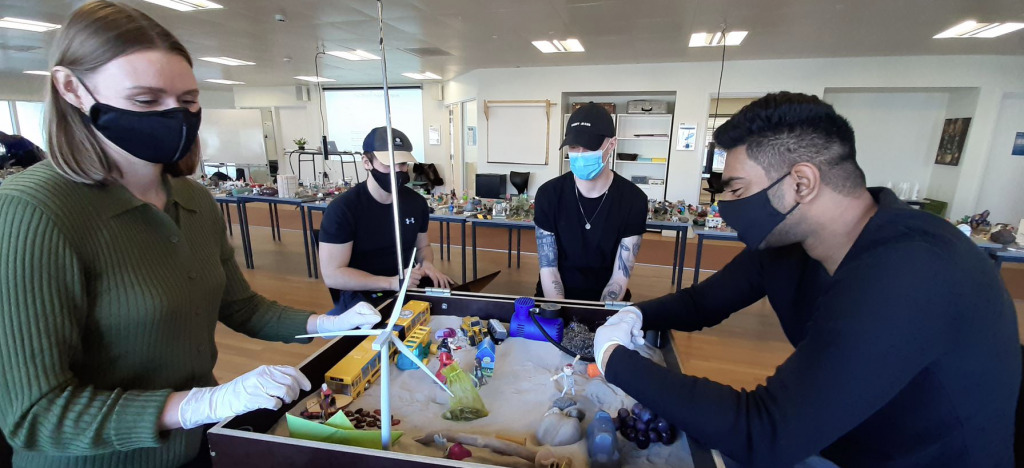
We started with every member of our group choosing different objects and put them in our sandbox – in silence. We chose objects which symbolized something related to our case – still in silence. Afterwards, we talked about the objects, why did we choose them and what did they represent for us when we chose it and what did they represent for the rest of us?
Then we used the artefacts to do storytelling about our case. The artefacts symbolized different aspects in our case and it was helpful to visualize the different aspects. It helped us see the challenges and the problems and also some solutions. Afterwards, we rearranged the objects and began to discuss solutions and ideas for the case. So in the end it helped us visualize the main problem.
Day 5: Innovation tracks
What are your key insights from your research?
- Important to know the content of resources
- Important to know about types of material and what kind of materials they are using
- Potential for a market outside the port (facilitate a network of companies, even outside the port)
- Make sure about the company’s willingness to contribute for CSR
- Think as an eye of a customer- what they need to know and what data they might need before investment
- Importance of a potential location for a new company ( a location near companies who has resources they need )
- A structured communication for each company that port of Aalborg collaborate with
Translate insights into quality criteria
- Easy to use – simple
- Needs to enable communication between companies and also the port of Aalborg
- Able to store data and showcased/manage it
- Detailed information on material
- Show rentable spaces
- The road map that indicates what location is best fitted for the company

Core design approach
From the information gathering and discussing from the first week the following core design was picked. The system in question is a sharing hub idea where companies would be able to go into the app/ website and be able to find info about other companies in POA. The system should also allow for sharing and contributing resources available from different companies and showcase what is for sale or what is needed.
System requirements
- Easy to use – simple
- Needs to enable communication between companies and also the port of Aalborg
- Able to store data and showcased/manage it
- Detailed information on material
- Show rentable spaces
- The road map that indicates what location is best fitted for the company
Day 6: How might we question
How might we? question and ideation framework
For this next step in our design we worked with the method of how might we question to open up a brainstorm session and get ideas to solve our design challenge. How Might We (HMW) questions are the best way to open up Brainstorm and other Ideation sessions. HMW opens up to Ideation sessions where you explore ideas that can help you solve your design challenge. For this sprint, we conduct different empirical and theoretical research to narrow down their core design for this sprint with the use of innovation tracks for possible concepts to show for the case partner. From the different meetings, it was concluded that we would work with a system that involves creating some kind of social hub tool that will help in creating a sharing network between companies in POA and companies outside the POA.
To further our development meant in exploring different ideas to solve the design challenge we took the use of the How might we question in regards to the quality criteria that were found during the first week in the sprint.
How might we create a tool for the core system (a hub for information)?
How might we add the possibility to sell resources with a few clicks?
How might we create a good communication tool for any kind of technical level?
How might we create a system that is easy to use?
How might we store the data and showcase it?
How might we present the data for the companies?
How might we present the visuals of the design?
How might we introduce companies for the tool?
How might we add a road map to indicate the locations of a POA?
How might we introduce the tool for selling/buying resources?
How might we create awareness about POA and the green initiative?
How might we select the correct data for the showcase on the tool?
Shared How might we question from above 3 generated HMW questions
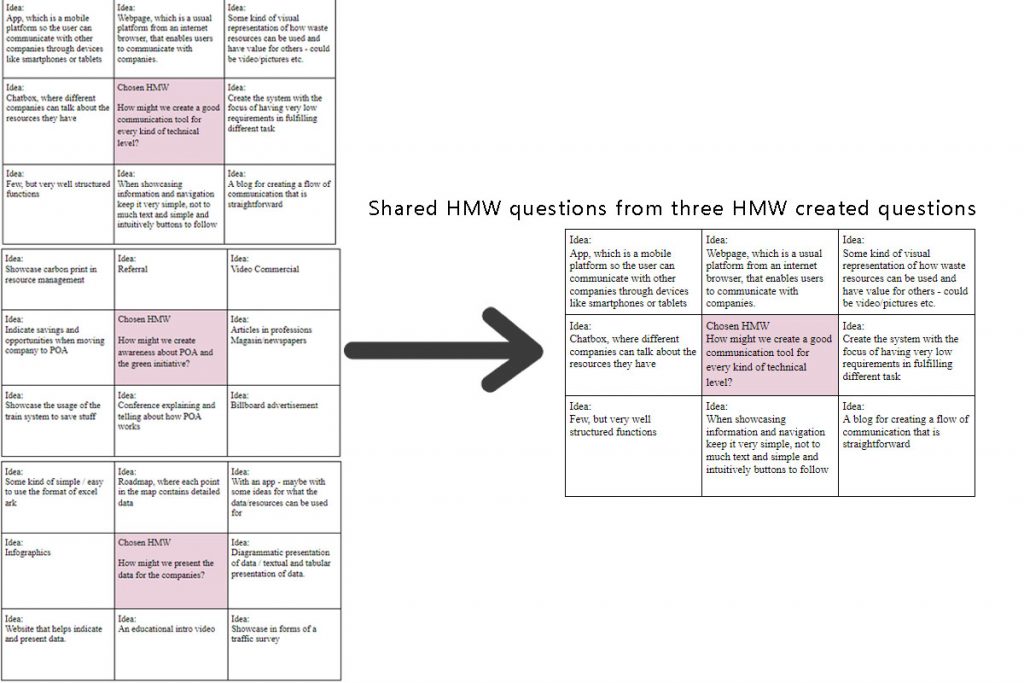
Refine 5 idea form the above HMW question into 8 complementing idea
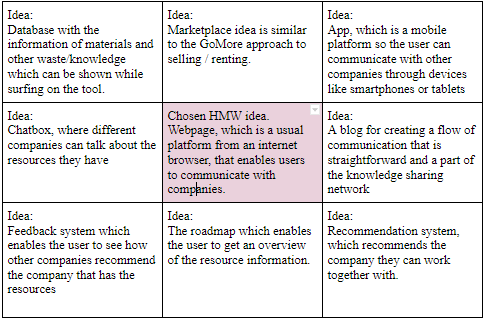
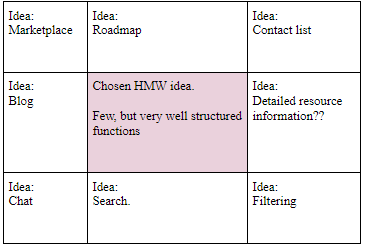
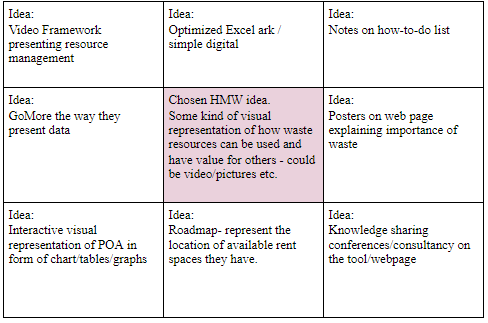
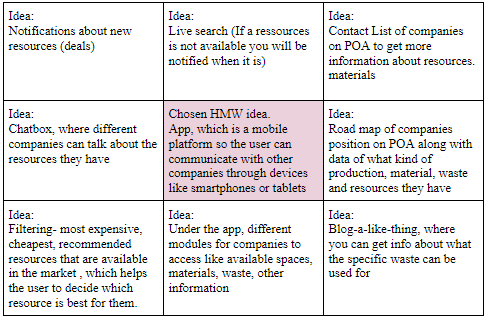
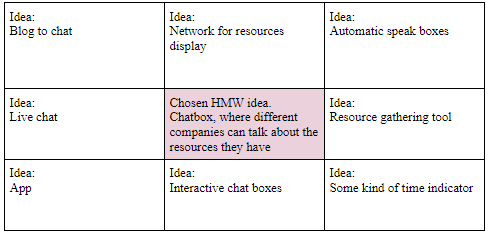
Ideas from HMW question
So by defining the question in a solution-oriented format we have created different steps into ensuring variables that need to be worked on during the creation of the system. Below three ideas have been picked from the above picture and will be the focus for the prototyping.
- Blog-a-like-thing, where you can get info about what the specific waste can be used for other companies
- Marketplace idea.
- Filtering- most expensive, cheapest, recommended resources that are available in the market, which helps the user to decide which resource is best for them.
- Video Framework presenting resource management.
From the above question, we need to relate them in regards to our HMW questions.
The Blog a like idea comes from the knowledge gathered during the first sprint week, which indicated that the users and POA needed some kind of tool to be able to create a good flow of communication.
The Marketplace idea stems from the needs to be able to share resources between the companies to save money essentially.
Video framework in regards to resource management – showing a graphical representation of how resource allocation, waste utilization and material sharing benefits companies and POA for being a more sustainable and green port.
The conclusion from day 6:
Result from our brainstorming of HMW questions, we have finalized our thoughts as 1 main question -|Webpage, which is a usual platform from an internet browser, that enables users to communicate with companies. For this, we will build/generate ideation framework with sketching ideas individually.
Day 7-8: Design video concepts
Prototype ideas
Ideas from idea generation
- Blog-a-like-thing, where you can get info about what the specific waste can be used for other companies
- Marketplace idea.
- Filtering- most expensive, cheapest, recommended resources that are available in the market, which helps the user to decide which resource is best for them.
- Video Framework presenting resource management.
Video sketching ideas Deliverable 3-5 visualised concepts
Concept 1
Website presentation showcasing the market place as the key focus. The idea for the marketplace is that the company will be able to see and add resources up for sale.
Filtering idea
Search
Most expensive
Cheapest
Recommendation
The first concept is a website presentation showcasing the market place as the key focus. The idea for the marketplace is that the company will be able to see and add resources up for sale. We will make a prototype of the website through Figma and furthermore make a screen capture with a voice-over presenting the different aspects of the website.
Concept 2
Stop motion ideas present the case introducing the user/company having some sort of problem they need to find a solution for when one person gets the idea to use POA’s tool for putting the items up for sale.
Concept 2 is a stop motion video. The video will present our idea starting with introducing the case and with a user/company having some sort of problem with waste resources. The user/company needs to find a solution. One person gets the idea to use POA’s tool for putting the items up for sale and then they a company who would like to use the waste resources contacts them.
Concept 3
We will use Prezi as a presentation of the product, then use Figma as our demonstration of our website.
Concept 3 is a combination of a Prezi presentation and the prototype of the website in Figma. Prezi will present the product and Figma will help us demonstrate our website.
The presentation will start in Prezi with an introduction to the current situation and the current problem. Then we will introduce the goals and hereafter the solution and our website. We will explain the resource exchange that will happen on the website and how it will work and optimize the current situation. The use of the website will result in a more sustainable world. The more companies being a part of the POA network, the more sustainable the industry will become.

